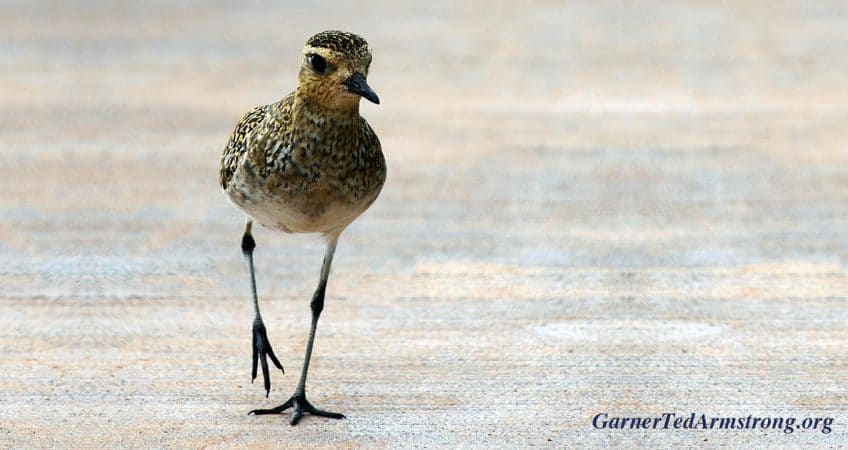Birds, fish, whales, butterflies and frogs all have something in common. Hundreds of species of them migrate. They move from north to south, from east to west, up and down, back and forth. Golden plovers and Arctic terns navigate thousands of miles—from Arctic to Antarctica—twenty-two thousand miles round trip, in the case of the Arctic tern. They fly by day or by night, over featureless seas, oftentimes out of sight of land, and above cloud layers. HOW? When did the very first bird or other creature migrate? The migration of these creatures leaves evolutionists utterly lost—wandering endlessly in a sea of bewildered funk—totally confused.
“Twin Cessna seven zero five, five golf.” The call sign crackled in my ears from the speaker over my head, clearly heard over the drone of our engines. I reached for the hand-held microphone mounted beneath the control pedestal below my right knee, pressed the button, spoke into the mike, “Five, five golf—go ahead.”
“Five, five golf, it appears you’ll need to correct about, uh, thirty degrees to your left to make good a track for Dalhart; you’ve drifted south of course.”
“Five, five golf—roger.” The call was from Albuquerque Center, keeping track of our flight aboard a twin Cessna 421, a pressurized, cabin-class twin, as we flew our IFR (instrument flight rules) flight from Montrose, Colorado, to Tyler, Texas. We were cruising at twenty-five thousand feet, over four miles above the earth. On autopilot, I had been steering with the heading “bug” in our directional gyro, mounted in the exact center of the primary flight instruments on the panel.
Immediately above it was the artificial horizon, showing a field of blue representing the sky, and covering lines painted on dull brown representing the earth beneath, and the distant horizon. Superimposed on this interesting little portrayal of the physical elements were little orange slashes, representing our wings, and an orange dot, representing the fuselage. If they were out of line with the painted horizon, it meant we were in a bank. Below the horizon, and we were heading down; above, with only the blue of the painted sky showing beyond the artificial airplane in the instrument, and we were climbing. The degrees above and below the horizon were clearly marked.
To the left was my airspeed indicator, and to the right, the altimeter. The RMI (radio magnetic indicator), with its two needles, a fat one for my primary (number one) VOR (very high frequency, omnidirectional radio range), and a thin one for my ADF (automatic directional finder), was to the left of my DG, or directional gyro, and on the right was the instrument that told me, in the number of feet per minute, whether I was ascending or descending.
Scanning these and other instruments, like the electric “turn and bank” indicator (that most pilots call the “needle-ball” instrument), all appeared normal. Thirty degrees off course? But how could this be?
Mounted on the metal frame separating the two sections of windshield was our magnetic compass. This instrument, of all the others in the airplane, was the one absolutely incapable of lying to us; a “compass correction card” displays each individual compass’ peculiarities perhaps a degree or two of variation due to various factors; the metals in the airplane, position of mounting, or the instrument itself. But after these are established (before the airplane is sold), the only thing which can affect the compass is some irregularity in the mineral deposits in the earth. Charts far north, or over the Mesabi Iron Range, for example, have notices, “Compass readings unreliable in this area.”
How embarrassing.
Here I was, a pilot of nearly six thousand hours’ experience—having flown in about sixty-eight kinds of airplanes, and eleven kinds of jets—an instrument rating on my license saying I am qualified to fly in solid cloud or in stygian night, depending on my instruments alone to bring me safely to my destination. Yet, the anonymous voice from the controller, probably sitting hunched over a circular radar screen down there perhaps at Alamosa, Colorado, yet connected by his computers and cables to Albuquerque Center, the controlling facility along our assigned route of flight—had seen the tiny blue-green “blip” that was our twin engined airplane steadily progressing along a portion of the sky we had no business occupying. Thirty degrees. The longer we flew with that error, the wider the margin by which we missed our destination. Instead of Tyler, Texas, we would probably have made it to Nuevo Laredo, Mexico. A rather wide margin of error! But we would have run out of fuel far short of such a destination. It was comforting to know we were over land—if the rugged mountains of south-central Colorado—for if our destination was but a tiny dot on the chart, like it had been for me so many times when I crossed the Atlantic in the Falcon Jet, landing at Santa Maria in the Azores, or Tenerife, in the Canaries, such an error in steering would mean our last flight, if it went undetected, and uncorrected.
Obediently, I reached up, turned the heading bug to 070 degrees—begrudging the movement and subsequent banking of the airplane as the autopilot immediately sensed its new command and turned to the new heading—for the instrument before me now told me confidently we were heading twenty degrees north of east—and from our position in southern Colorado, that was hardly the route to Tyler, Texas.
And then, as Benny Sharp and I both scanned the instruments in the cockpit, we looked at the magnetic compass and again checked it with our directional gyro. They were thirty degrees off!
Chagrined, betrayed, I punched off the autopilot, hand-flew the airplane as I pushed in on the “caging” button on the directional gyro, spun it back around to conform to the magnetic compass. This was not possible, and would not be accurate, unless we were in level, steady flight. The compass requires time to settle down after each turn.
As I turned the directional gyro to conform to the magnetic compass, I watched the RMI spin obediently in the same direction.
“Something wrong with the slaving mechanism,” Benny muttered. The “slaving” mechanism is a feature of all flight director systems, whereby an electric signal is fed into the gyros serving the DG and RMI to immediately indicate the exact magnetic compass heading of the airplane when they spin themselves erect once energized.
Now that we had a suspect, we watched the slow creep of the gyro throughout the remainder of the flight. It was so slight that no discernible banking of the wings occurred. The “ball” in the turn and bank indicator remained in the exact center, so far as we could tell, and with autopilot engaged, and the yaw damper on, we supposed we were in steady, level flight. Yet, about every ten to fifteen minutes, our airplane would be heading five or six degrees to the south of our intended track. Toward the end of the flight, we suspected the malfunction was in the RMI. “We’ll have to squawk the RMI—have them pull it out and bench-check it,” we agreed. Tedium. Problem. No adequate avionics shop existed in Tyler. The problem meant “down time” for the airplane. It meant a flight back to Dallas where adequate service could be obtained to correct the problem. It meant money.
Far below us, as we flew, were thousands of creatures. Rabbits, snakes, frogs, armadillos. Birds—Aucks and geese—gabbled happily on tens of thousands of farm ponds dozens of rivers and lakes, or flew in their neat, V-shaped echelons, following their leader to some predetermined destination.
Poor creatures. They aren’t equipped with tens of thousands of dollar’s worth of electric and magnetic instruments. No gyros, or artificial horizons. No turn and bank indicators, no RMI’S, and no ADF’s or autopilots. or flight directors. No props. Their wings and props are the same thing.
Only difference was—they weren’t thirty degrees off. They knew exactly where they were.
The ludicrousness of fumbling human beings, dependent on various sophisticated directional devices reminds me of the inebriate who, staggering down a street in Brooklyn, encountered a small sapling. With his head pressed against the tiny tree, his hands grasping its slim trunk, he commenced to walk around and around the tree—keeping his nose pressed against the bark. At length, he slid to the pavement, still grasping the tree, and cried out, “LOSHT! Losht and alone in an impenetrable foresht!!”
Many is the student pilot—or supposedly professional one—who has been lost. Some of them become lost almost over their home fields, for, believe it or not (and this is especially true in the flatlands), everything begins to look the same when you’re high in the air.
How many grizzled instructors have tiredly calmed the fears, stopped the flow of clammy perspiration and the quaking of suddenly feeble knees by sourly pointing below and behind and saying, “It’s over there”?
A few years ago, a Cessna Citation (a small, corporate jet) landed at Gregg County Airport. A good friend, Royce Barnwell (“Barney” to his friends—Barney, who amassed more hours in B26’s than any living man) operates Gregg County Aviation. Sensing a possible fuel sale, he walked to the ramp, waved his arms, and indicated where the taxiing aircraft might park.
The engines’ scream became a tired whine and stopped. The door opened. Two Mexican nationals exited. One of them looked about, curiously, and said, “Donde esta’ Monterrey?”
I almost collapsed, laughing, when Barney told me the story. The two had been to Wichita to take delivery of a brand-new Citation. They were taking it to its proud owner in Monterrey, Mexico. Almost. Except they became lost, and landed in Gregg County, Texas, near Longview—only about sixty miles from Louisiana!
Finding Your Way
How good are you at directions? You probably fancy yourself a reasonably intelligent human being. Surely, you are infinitely smarter than, say, an albatross. But have you ever flown in a commercial airplane, looked out the window at the monotonous sameness of the terrain below, and wondered where you were? Ever landed in a strange airport at night, been taken to a hotel in a taxi, and awakened without the slightest concept of which way was north?
When you last packed the family car and set out on a cross-country trip, didn’t you have to consult a map often? Follow the marked road signs? Perhaps ask directions at gas stations?
We human beings may be intelligent in many ways. But we have no built-in sense of direction. Spin us around, convey us about in the dark, take us for a lengthy ride in the back seat of an automobile, and we may become hopelessly lost. Many are the chilling stories of disaster or barest survival from hunters, hikers, or seafarers who became disoriented.
Not so for the tiniest of birds. Not only are they perfectly equipped to do what they do—to build nests, obtain food; to survive—many of them migrate over vast distances, under the harshest of weather conditions, Out of sight of land! How? Can evolution explain it?
Bird Migration
Many species of birds migrate—some of them for only a few hundred miles, some of them for thousands of miles. Wilson’s petrel, for example, makes the trip from Antarctica to the North Atlantic every year, a one-way trip of nine thousand miles. The little Kirtland warbler flies each year from the Great Lakes region to the Bahamas, about 1,200 miles.
The golden plover manages an eight thousand mile trip; the bobolink seven thousand; the Arctic tern from fourteen to twenty-two thousand miles, round trip!
Surely, you have heard the mournful distant honking and calling of wild geese in flight. Each year, vast numbers of ducks and geese leave their summer feeding grounds far in the north, in Canada, or Alaska, and wing their way south. Millions of them winter in south Texas and other gulf-coast states. Many go on to Central or South America.
But, WHY?
Well, weather is the answer. It takes no great “scientific” observation to realize that, with winter arriving, the sun’s rays become longer. Shorter days, longer nights, and bitter cold invade the northern hemisphere.
In the hostile, winter environment, food would be unobtainable. The rivers, ponds, and lakes freeze over, so millions of waterfowl couldn’t dive for their aquatic food, or feed on water plants, small fish, and insects. The tundra freezes; heavy snowfalls cover even the mosses and lichens upon which some birds feed; the frozen north becomes a bleak, barren, frigid, silent, seemingly lifeless wasteland.
Yet, evolutionists cannot answer the mysteries of bird migration merely through observing that weather changes force the birds to look elsewhere for food. Why? For the simple reason that the birds begin their journey just when their food supplies are at an absolute peak—BEFORE the storms of winter begin to fall upon them!
Evolutionists speak of the “mystery” of bird migration. So much for that. “It’s just another one of those ‘mysteries,’ ” they say—and then go confidently ahead, teaching evolution. Unfortunately, the entirety of evolutionary thought is a “mystery”—and it is a mystery how any thinking, intelligent human being could believe it, when presented with the real facts.
The Illustrated Encyclopedia of Animal Life says, “There is no more fascinating way of arousing interest in flight than having your child catch sight of migrating birds—perhaps a flight of geese in military formation, or a close-massed flock of grackles racing like a dark, wind-blown cloud. Even after years of research and experiment, scientists speak of the ‘mystery’ of bird migration, for they still do not completely understand it” (Vol. 1, page 17, emphasis mine).
“. . . the real mystery is still unsolved,” says Robert Allen, in his book, Birds, page 9. “The greatest mystery about bird migration is the ability of many birds to move over the same route, year after year, arriving each spring in the same nesting locality and spending each winter in the same place”(emphasis mine).
Not only birds migrate. Such tiny creatures as ladybird beetles migrate. So do monarch butterflies, bats, eels, elephants, horseshoe crabs, king salmon, turtles, plankton, locusts, lemmings, frogs, whales, tuna, and dozens of other species!
But how? Why? When did the very first bird migration take place? What strange, built-in instinct, or compulsion, causes these creatures to know when it is time to depart? What guidance system leads them unerringly across featureless seas for thousands of miles in the darkness of night? How can a tiny insect, like a colorful ladybird beetle, with a “brain” virtually microscopic in size, migrate over vast (to him—or her!) distances?
Let’s turn to the prestigious book by Wesley Lanyon, called Biology of Birds. After all, it’s a collegiate-grade, well-done, thoroughly-researched textbook on bird biology. Whatever we want to know about birds, especially bird migration, we ought to find here! Pages 68, 69, the index says. Here it is. “One of the questions most frequently asked of an ornithologist is, ‘Why do birds migrate?’ “—Hey! GREAT! That is exactly the question WE wanted to ask when we turned to Lanyon’s book! His answer?
“WE CAN ONLY SPECULATE as to what these factors may have been, for it is IMPOSSIBLE to substantiate these theories with experimentation” (emphasis mine).
Well. So evolutionists aren’t going to be much help, after all. They only call it a “mystery,” say “We can only speculate,” or tell us they “do not completely understand it.”
Can Science “Explain”?
Some experimentation has been conducted. Unfortunately, the experiments only serve to further confuse the befuddle scientists, so long as they cling, stubbornly, to their evolutionary theories, their belief that there IS NO GOD who designed these myriad creatures and set within them these miraculous instincts!
It was found, for example, that young swallows, nesting on the European continent slightly south of the latitude of London, flew all the way to Africa to winter. But they flew only to the northern and equatorial parts—like Morrocco, Libya, Chad, etc. Yet, strangely, the exact same kind of birds, same species—same colorings, habits, nests, appearance; same kind of birds which were nesting in England—further north than their cousins in Europe, flew all the way to South Africa—distance TWICE AS FAR as their European counterparts.
WHY? Wouldn’t there have been enough food to go around in England?
Do all birds leave England each winter? No. Dozens and dozens of species stay in all winter. Especially the crows and sparrows! England may have bad winters—but surely they’re not all that bad. But the swallows migrate. Since evolutionists say it’s all a matter of the survival of the fittest, of strange compulsions having to do with food-getting, mating, nesting—you know, with SURVIVING—and since the sparrows survive quite nicely in England, why didn’t the swallows just swallow their pride, and decide to become sparrows? Why not just stay in England?
But no, they migrate—thousands and thousands of miles.
In one experiment, a migrating swallow was observed to return to build a nest on the same beam of a barn in Pennyslvania for three successive years.
There was an experiment involving the tiny, breathtakingly beautiful ruby-throated hummingbirds. We have them all around our house in Texas during the summers. They disappear every winter. I remember a neighbor lady cautioning others to “take down your feeding stations every winter, or the birds will stay around too long, and winter will catch them, and they’ll die.”
She need not have worried. Those plastic feeding stations you can hang outside your windows so you can watch the beautiful, tiny little creatures hover as they drink in the honey and water would never overcome the built-in migratory instincts of hummingbirds. They will leave just when their food supply is at the most abundant—whenever their built-in “migratory clock” tells them it’s time to go!
In the experiment, three tiny babies (about as big as your thumbnail) were banded by scientists. They grew up, fed around the neighborhood where their parents had nested, and disappeared with the other hummingbirds as fall drew on. They flew about five thousand miles, to the tropics of South America. Of course, no one saw them go—for within a moment of darting flight the little creatures are but a speck, and soon swallowed up in the distance. The next year, astoundingly, those same three birds, with the bands clearly in place on their tiny legs, were using the same feeding station their parents had used the year before. It was within thirty feet of where they had been hatched!
Hummingbirds have perhaps the most rapid metabolism among all living creatures, for their busy flight requires that they eat the equivalent of their own weight each day! Think of applying that kind of a diet to human beings, or elephants!
Ornithologists have determined that the tiny rubythroated hummingbirds fly completely cross the Gulf of Mexico to the Yucutan Peninsula, and down into southern Mexico and Central America for the winter.
Yet, the diminutive birds cannot find any food en route; not a single island, or branch of a tree upon which to rest. How do they suddenly leave their rich source of nectar in Texas, and, unable to eat the equivalent of their own body weight each day, sustain flight for many, many hours?
Some strange “genetic urge” begins to trigger the deposit of increased fat—like stored energy—in the bird’s bodies some weeks before they begin to migrate! But how? Remember, the very first migration from Texas to Central America had to be successful. But long, long ago, in the evolutionary scheme of things, when the very first ruby throated hummingbird “decided” to migrate across the vast, trackless waters of the Gulf, the little bird didn’t “know” that its body needed to begin collecting much more nectar than for daily sustenance. There was no “genetic urge” to begin depositing body fats around the breast muscle for long-range flight!
So when the very first hummingbirds attempted the very first migration, naturally, they “ran out of fuel” about twenty miles out over the Gulf, fell into the water, exhausted, and drowned. Therefore, since there was no hummingbirds left to “experience” the benefits of migration, there was no need to migrate. Since they all died, there are none left today.
But there are tiny rubythroats today, and they successfully migrate each winter.
Evolutionists might suppose, “Perhaps they tried to migrate, and failed, turning around just as they tired, and made it safely back to land.” Then, they might surmise, “perhaps succeeding generations attempted flights further and further, ‘gradually’ adding to their body fat to sustain prolonged flight without food supply.”
Why? Why, when not a single one of these increasingly prolonged flights netted a single drop of nectar? Are we to assume the tiny birds kept at it for thousands, perhaps millions of years, failing each time, until finally the first pair succeeded? And, since they had to turn back, and there were no flowers blooming during all those millions of winters, and they starved to death the very first winter, then there are no rubythroated hummingbirds in Texas.
But there are.
Confusing, isn’t it?
It is confusing if you cling to the concept of evolution to somehow explain the fabulous intricacy of God’s great creation; His amazing design of His creation; His awesome mind which thought out, planned, and brought into being each of His amazing living creatures.
The only way to understand the “strange genetic urge” which causes the little rubythroats to begin storing body fat instead of burning it up each day; which causes them to leave Texas just when their food supply is at its peak; which causes them to fly unerringly across the vast Gulf of Mexico, hundreds of miles, and navigate perfectly to their desired landfall, is to understand God built into them that instinct; God caused that genetic urge—they did not “evolve” it!
The Amazing Golden Plover
And then there is the marvelous story of the golden plovers. They nest along the coastlands of the Arctic Ocean—in the faraway land of permafrost, muskeg, seals, white whales and polar bears.
After raising their young, feeding them all through the summer until the young are able to fly with the parents, the golden plovers somehow feel a strange compulsion to leave the hospitable, friendly environment of their nests, where ample food supplies are readily available, and begin one of the most awe-inspiring migrations in the bird world.
Unerringly, they point their beaks southward, flying an elliptical course along routes only they seem to know, covering more than sixteen thousand miles!
Observers in Labrador, on the tip of Nova Scotia, see them flying through. They completely bypass the lower forty-eight states, winging their way over the trackless Atlantic, perhaps first sighting land again along the tip of Cuba or Haiti. Their next landfall is undoubtedly somewhere near Guyana or Venezuela. Across the famous rain forest of the Amazon, the “Matogrosso” of Brazil they fly, until arriving at their wintering area located in southern Brazil, Uruguay and Argentina.
There, while frigid winter storms howl across the frozen tundra they had departed, they happily feed and spend their days in the sunshine of summer in these southern latitudes.
Again, just as their food supply is at it’s peak, and before there is any discernible reason for them to depart, they begin a northward migration. But they do not retrace their mysterious track across the open Atlantic! Instead, they point their beaks northwest, cross the towering Andes range (with its peaks such as Aconcagua, higher than twenty-two thousand feet!), reach the Isthmus of Panama and Central America, fly across the Yucatan Peninsula and the Gulf, reaching a landfall somewhere around south Texas and Louisiana, wing their way up the Mississippi Valley, across the northern states flanking the Great Lakes region, into Canada, and onward to their home in the remote Arctic!
What a trip!
It would be a laborious, virtually impossible trip for me even if the Cessna 421 had an inexhaustible fuel supply without special over-the-water navigational equipment. It would be a comparatively easy trip in a modern, sophisticated jet aircraft with more than three thousand nautical mile range, equipped with inertial navigation systems.
However, even these super-sophisticated systems (the type computers which took men to the moon) may be as much as one-half mile off at the end of a three hour flight! They certainly could not take me to the same beam in an individual barn, or to the same gravelly bank along a tiny creek where a parent’s nest might be found!
Remember, the golden plovers leave their nesting area when their available food supply reaches its peak. All of their foods, tiny crustaceans, arctic plants, insects, etc., are in the greatest abundance at this time.
Evolution supposes there are various compulsions somehow built into these birds which cause them to go in search of greater food supply!
But how can evolution explain them leaving when their food supply is so adequate?
No, “weather” is not the compulsion which causes migration in every case.
Species after species leave Canada and the northern states in the contiguous forty-eight in mid-summer, in the HOTTEST time of the year, long before there is any hint of autumn, let alone winter!
By the way, there are many other cases of migration back and forth within the tropic zones, having nothing whatsoever to do with weather!
Can you believe it? Some have actually proposed that birds began migrating, anciently, in the face of “advancing glaciers” during the Pleistocene “ice age”! Think about it. Just how fast does a glacier advance? It may move a few feet, or even a few hundred yards in a year! But it moves far more ponderously and more slowly than a three-toed sloth, or than the proverbial molasses in January!
Further, there are penguins in Antarctica! Other birds depart, mysteriously, winging their way up across Africa, into Europe, or along South America up to the United States and Canada!
Yet, the penguins remain where they are!
Why didn’t the terns, anciently, simply turn into penguins? There they are, with the very richest oceans of the world all around them! Scientists know that the extremely cold seas around Antarctica are the feeding grounds of many species of the great whale; that many types of seals and other huge creatures are at the top of the food chain in this region. “Krill,” or plankton, crustaceans, small fish, and sea life are abundant in Antarctica!
This sea life is the basis of the penguin’s food supply!
Can evolution have it both ways?
Can they confidently tell us that the vast number of birds spending their summers on Antarctica but which mysteriously leave just when their food supply is at its peak do so because, anciently, some compulsion caused them to LEAVE Antarctica to go back to the north (where summer would soon be coming on) in order to SURVIVE? Then, are they going to tell us that the penguins GRADUALLY evolved their wings into flippers; evolved the sack into which to deposit their eggs so it could be incubated away from the cold; evolved their big, webbed feet, and powerful beaks for catching fish—evolved their thick, protective winter “Coats” and took to diving after krill in order to survive?
Stimulation for Change
Evolution tells us the stimuli for adaptation or survival are a wide variety of food-getting techniques, nest building, egg laying, feeding of the young, coloration and camouflage, protective armor (as in the case of porcupines and armadillos), etc., etc.
Thus, as you look closely at each creature, whether penguin, Arctic tern or golden plover, you see fully-formed perfectly-functioning methods for food getting, egg laying and incubation, feeding of the young; in short, astounding techniques for survival. BUT HOW? WHEN? In order for each of these species to have such intricately-functioning food getting and survival techniques, each species had to be successful on THE VERY FIRST TRY!
If not, if for some reason their food-getting and survival techniques were inferior—if they failed in the distant past, then they DIED! They didn’t survive. If they didn’t survive, then they aren’t here, today! But here they are, in all their amazing splendor, with their mind-boggling proclivities which science cannot explain.
The Arctic Tern
Most people, seeing an Arctic tern in flight, would believe they were looking at a seagull. The terns nest in the extreme north, along Hudson Bay, across the northern territories of Canada, and along the west coast of Greenland. Some may nest as far south as New England.
The annual migratory pattern of millions of these birds is so vast, so impossibly complex, that it presents a great MYSTERY to ornithologists and evolutionists.
For example, the terns nesting in the Cape Cod area (and this is the southern-most nesting area for the terns) depart just when their food supply is at its peak, fly across the Atlantic Ocean to offshore Spain, then continue along the west coast of Africa to cross the Atlantic again until they reach the easternmost tip of South America!
Then, they follow the South American coastline to Antarctica! Why? Some of the birds flying such a tortuous route actually cover as much as twenty-two thousand miles! Unerringly, they return from far away Antarctica back to the very same nest; the same rocky shore, inlet, creek, gravel bed or sand pit that they departed!
Scientists have speculated that the birds migrate by the stars.
Stellar Navigation
Some ornithologists have conducted experiments with captured birds, introducing “fake sunlight” or artificial stars into their environment, and have been amazed to see the birds line up in appropriate direction, according to the travel of these fake sources of light. In absolutely black, featureless “skies” the birds were completely disoriented. Some naturalists believe birds may be able to determine where they are from the slant of the sun exactly the way a navigator may take his noon sight with a sextant! According to one biologist, the calculations involved for a bird to do this are so enormous that they “involve so much mathematical calculation that you would think only an IBM machine on wings could get anywhere with such a shifting point of reference. Nevertheless he is convinced that the migrating and homing birds are equipped by instinct for such a feat” (Our Amazing World of Nature; Its Marvels and Mysteries, G.V.T. Matthews).
E.G.F. Sauer of the University of Freiburg, Germany, conducted an exhaustive study of warblers which migrate over vast distances—mostly at night. If you have ever been to a planetarium, you may have witnessed an artificial reproduction of the heavens, wherein one sits in a theater, and watches the movements of the heavenly bodies as the world rotates. Dr. Sauer placed the warblers under such a dome—where they could only see an artificial reproduction of the night sky. If he rotated the artificial sky in a wrong direction, the little birds were completely disoriented—that is, they aligned themselves according to the false position of stars in a fake environment! Yet, when he rotated the planetarium sky correctly thewarblers lined up exactly in accordance to the direction of their intended migration!
The Very First Migration
Since evolutionists claim we are the result of blind chance, of gradual evolutionary processes brought about by external stimuli (survival) over vast epochs of time, would it not be logical to assume that we, as the very PRODUCT of evolutionary processes, should be able to understand the processes by which we came to BE?
Why not apply, pragmatically, the presumptions of evolutionists to bird migration?
Let’s imagine an Arctic tern up in the extreme north of Canada, nearly to the Arctic ice cap, sitting on its nest. Never mind, for the moment, what the bird is doing there (we will have to remind ourselves again and again in this exercise not to ask embarrassing questions!)
Our beautiful black and white tern doesn’t know he is a tern. He is only a “creature” of some sort, surviving quite nicely as August and then September pass.
All around him, the Arctic tundra is rich with insects, crustaceans, soggy bogs and marshes wherein myriad aquatic forms thrive. The nearby bays and estuaries teem with tiny fish.
He walks along the bogs, pecking at insects and tiny crabs. He flies to the nearby shores, eating small fish.
The weather begins to chill. Winds howl, storms blow in. Snow begins falling, and one night in late September, the water in his favorite bog freezes.
He stretches out his wings, flaps them several times. Nothing. He flaps them again! What? He isn’t moving. He looks down in disgust. His feet are frozen in solid ice! All around him are other terrified terns, trying to tear their tiny toes from the freezing grip of the ice. But all are stuck fast. They mournfully call to each other as the next storm, and the next, descend with the madness of winter’s fury. All die. None survive. Terns do not exist. The first terns didn’t have the instinct to leave when their food supply was at its maximum—to avoid being trapped by winter. They waited until the weather forced them to leave, because they hadn’t yet “evolved” this amazing instinct, this sixth sense of timing—hadn’t yet passed it on, genetically, to their progeny. So they all died. None lived.
But we’ll suppose, somewhere, a few terns decided the first chilling nights signaled them they should leave. Of course, they knew nothing of the jet streams; they didn’t know that it could be warmer here, sometimes, than it could be in Florida! But they decided to go south, like any thoughtful tern.
The further south they flew, the colder it got. In Minnesota, they saw hundreds of species of small birds, hopping about on the snow. Some drilled their funny-looking beaks into tree trunks, shot out a long, barbed and sticky tongue, and ate larvae that attack trees. The terns decided to try this. Several died of a broken neck. One caught his beak in a crack, and was frozen solid, unable to move. Several flew dizzily around in circles, a powerful headache throbbing in their tiny brains. Others, not having “evolved” the ice-tong-like feet of a woodpecker, could only flap uselessly at the tree trunks, making a feeble peck here and there—bending their beaks, failing to penetrate the hard bark. But the woodpeckers kept on tattooing the trees—happily surviving.
Beneath, rustling about in the leaves from the autumn, were thrushes, larks, grackles, chickadees, and several other species. This appeared easier than banging their heads against bark, so the terns stayed in Minnesota, and gradually “terned” into tiny tanagers! So there aren’t any terns, today. But there are.
Well, let’s speculate that the first truly successful migrators simply flew out to sea, intending to cross the Atlantic (how did they know it was there? How did they know the world is round? How did they know they wouldn’t fly off the edge, be sucked into a terrible vortex of intergalactic wind, and have all their feathers stripped off?—but we’re not supposed to ask such questions!). They fly for a couple thousand miles, or so. Then, they begin to become disoriented. None of them had ever paid the slightest attention to the sky before. What are all those tiny, blue-white lights up above? They didn’t know. Oh, they might have wondered about the big, white disk that seemed to change shape as the months passed but you could never depend on it. It moved around crazily in the skies. It would be on one horizon, and then the other, looking like a sliver of white, or a big yellow orb, squatting on the horizon.
Now, they were flying along, two thousand, seven hundred miles south, southeast of Labrador—underneath an overcast. They flew in circles. Gradually (for everything always happens “gradually” in evolution), they ran out of gas—body fat, to the uninitiated.
You see, they can only remain in flight so long as they have energy to fly. But they are leaving the far north only because their food supply has been covered up under tons of snow and ice! We won’t wonder about how long they lost weight, tried to peck a hole in the ice and go ice fishing, or eat snow, or…
And so, as their body fat is used up, one by one they let out a squawk, drifted down in crazy, random (everything in evolution always happens randomly) patterns, and fell into the sea. None survive. Terns don’t exist.
But let’s imagine some few terns made it to the coast of Spain. There, in sunny Spain, were hundreds of bird species. All along the rocky coastlands over which they flew were gulls, cormorants, several species of ducks, falcons, pigeons—further inland were warblers, blackbirds, finches, Wrens, thrushes, sparrows; dozens of other species, including ravens! So they stayed in Spain, and evolved into sparrows! There aren’t any terns.
But there are!
Somehow. those first migrating birds who left at the exact moment; who didn’t become disoriented; who knew solar and stellar navigation; who had accumulated enough body fat, somehow knew they should pass by Spain—that they must not begin fishing in the rich waters of Portugal, or stop in the Canary Islands, and become a you-know-what!
On to the coast of Africa they flew.
Birds don’t sweat, or ooze, like their “closest living relatives—the crocodiles!” (That’s right! That’s what evolutionists believe!) But these birds were winging their way in the late September right along the equator! It was hot! Furthermore, in the jungles below them, in Senegal (they didn’t know it would someday be called that—but then they didn’t know this was Africa, either!) were millions of tasty creatures; small mice, rats, grubs, worms, beetles, bugs, moths, weird-looking fish, crustaceans; a veritable banquet of edible bird food. Did they stop? No way. No tern was going to “tern” into Africa and become a crocodile again—they had had it with crawling about on their stomachs in swamps. Nosiree! These terns were going first class—they were going to fly!
And so they flew out across the Atlantic again—and died in a tropical heat wave. Now, our nonexistent, non-surviving, completely lost, hopelessly confused, starving terns (which don’t exist, for they could never have survived—not knowing navigation, where they were, where they came from, where they were going), are really in trouble, for, ahead of them, lined up like so many huge medieval castles, are thunderstorms whose tops tower up to seventy thousand feet! But they don’t know this. They think these huge things are mashed potatoes, or heads of cauliflower. Or snow. So they fly to the edge of the first big thunderstorm, and try to land. They are at only six hundred feet. Suddenly, they are sucked up into a violent updraft that carries them to twenty-thousand feet! Around them are grapefruit-sized hailstones. Lightning flashes, thunder rolls. They all die from lack of oxygen. Some are pelleted to death. Others have every feather ripped off by the winds. Still others fight their way to lower altitudes, evolve a genetic distrust of thunderstorms (this being the first one they have experienced) and decide to pass on the information to their young—whenever they next nest.
The survivors (but there aren’t any) cross the Atlantic once again, arriving at the mouth of the Amazon. Below them are myriad birds; macaws, parrots, finches, warblers, red-winged blackbirds; the rivers are teeming with juicy bird food. In the tropics, hundreds of exciting-colored birds survive. They perch on branches above the ugly snouts of alligators. Some even pick insects from the backs of alligators. Some even evolved into alligator toothpicks, choosing to pick the teeth of alligators, who like to lie around in the sun, opening their mouths to tiny birds, who eat food scraps from the alligators’ mouths.
The thoughtful terns toss this tantalizing possibility around in their minds.
Nope. Better not. If they stopped here, could they be an “Arctic” tern? No. Like Benedict Arnold, they might be called a “terncoat”!
So, on to the south Atlantic they fly. Past Uruguay, with its teeming forests, rich rivers and lakes—over thousands and thousands of miles of rich foods, hundreds of other species, millions of fish—they fly. Why? Who knows? They just “do”! But, wasn’t their initial “instinct,” or whatever, because they needed food? And haven’t they disdained a billion tons of food—from the east coast of the USA to Spain and Portugal; from Africa to Brazil? Yes—but we’re not supposed to ask such questions, remember?
On to Antarctica they fly—arriving there in the Antarctic “summer.”
All around them are penguins. The penguins look, curiously, at the terns, who turn, tiredly, in tortuous circles, to land on rocks, sprawl in the sun, and die from exhaustion. Actually, none arrived—they all died much, much earlier.
But the penguins begin to discuss it.
They decide the terns are foolish. Much better to simply evolve into a penguin, and dive for krill.
But they didn’t. Instead, they remained there during the Antarctic “summer,” happily surviving on the available foods. But since they had not yet developed the genetic “clock” that would warn them to leave long before the Antarctic winter arrived; since they could look all about them at various species of gulls, penguins, and other creatures, like seals, who were merely lying about, sunning themselves as if they hadn’t a care in the world, the terns stayed where they were.
Hadn’t they battled the elements, died by the thousands, struggled in the snows of Minnesota, and fought the thunderstorms of the equator to get here?
And so the Antarctic winter howled upon them with sudden intensity, and they all died. None survived. There aren’t any terns.
But there are.
So here we go again. Now, we’ve got to “imagine” the terns somehow “knew” when it was time to depart—”knew” which route to take, “knew” they should fly over billions of tons of tantalizing tern food, disdaining to remain there and evolve into a macaw or a red-winged blackbird, and wing their way up to the far north once again.
And if you believe all this just “evolved,” then I’ve got some great lakefront property in the Sahara I’d like to tell you about…
Evolutionists are Mixed Up
Ever pick an evolutionary textbook off the library shelf? Ever look through the introductory material; the first chapter?
If you do, you will run across expressions such as these:
“Out of man’s grasp,” “said to be,” “mystery,” “according to the theory,” “other ornithologists believe,” “no single solution,” “other theories proposed,” and “no adequate answer.”
Speaking of the “mystery of bird migration,” one “authority” came up with a truly classic line, “All theories fail when offered as the one solution to all migration” (Science News Letter, p. 19 1, September, 1962, emphasis mine).
Remember, “natural selection” and “survival of the fittest” absolutely require that various food-getting techniques have proved successful—and that those very techniques have contributed to the development and “evolution” of the species!
But evolutionists are rendered dizzy by the study of terns, plovers, warblers, hummingbirds, or, for that matter, any migrating species, from tuna to turtles, and from ladybird beetles to monarch butterflies!
One evolutionist must not have known what he was saying when he wrote, “If natural selection has been responsible for the evolution of the adaptedness of behavior in an animal, then the way that animal is behaving right now must obviously contribute to its survival” (Animal Behavior, Niko Tinbergen, Life Nature Library, p. 174, emphasis mine).
And that is the whole point.
They survive today by doing what they do. And they migrate. So, they had to MIGRATE to SURVIVE! And the very first migration had to be successful!
Undaunted, this source completed the quote by saying, “This is why studies of the survival value of behavior are not only important in their own right but are also required for an understanding of evolution” (ibid).
Oh. So we must understand “evolution” by understanding the complete “mystery” they claim they cannot understand?
Evolutionists tell us that there was a time when birds did not exist—except as disgruntled reptiles.
Well, now, let’s suppose there were no birds? Could this earth survive? Let a scientist tell us.
“Today, a countryside without birds would be unimaginable. And this is as it should be, for without birds HUMANITY WOULD FACE DISASTER.
“We have only to note how many different kinds of injurious insects are being continuously and tirelessly destroyed by birds, to see what part the latter play in saving our field and orchard crops from destruction, as so many kinds of birds are entirely insectivores.
“Equally effective is the help of birds in man’s fight against moles, mice, rats and other rodents which not only destroy the harvest in the fields, but also constitute a danger to human health as carriers of infectious diseases. These are only a few of the helpful roles played by birds in maintaining NATURE’S EQUILIBRIUM” (Strange and Beautiful Birds, Josef Seget, page 5, emphasis mine).
But notice what scientists tell us about the arrival time of birds and insects.
“Flying insects became a reality about fifty million years BEFORE the reptiles and birds took to the air, and for those fifty million years the only flying creatures were insects” (Insects, Ross Hutchins, pages 3, 4, emphasis mine).
But could the earth survive?
Let’s say it was only fifty million years, perhaps twenty-five million years, maybe five million years of difference. How about a thousand years? Would you believe a hundred?
Let’s see what would happen to a “birdless” earth!
“The descendants of a PAIR of houseflies, if they all lived and did well from April to August, would total 190,000,000,000,000,000,000 individuals. Fortunately, the balance of nature, in the form of natural controls, limits such population explosions among insects just as it does among other animals and among plants” (Insects, Ross Hutchins, page 9, emphasis mine).
Granted that insects eat other insects. Perhaps the earth would not be covered with forty feet of insects in one year.
But be sure that the earth COULD NOT SURVIVE unless birds and insects were CREATED TOGETHER to form that fantastic balance in nature, that man is just coming to understand.
Why don’t evolutionists think about the ecological implications of their theories for a change?
No, evolution has no answer for bird migration or how birds came to be such awe-inspiring creatures—just as they have no answer for the origin of MATTER, or the origin of LIFE!
It’s time you saw the real fallacies of evolution—time you faced squarely the ONLY ALTERNATIVE, that God DOES EXIST, and you can prove it!
There are thousands of similar problems for evolution. Regardless of sensational articles of the new “Scope’s Trail” in Arkansas a few years ago; of claims by scientists that evolution is true, when you take a really close look at the theory; when you apply plain common sense to their claims, you can see great flaws.
It’s no wonder evolutionists suffer a migration headache when it comes to bird migration.
You may copy and distribute this information only to friends and family without changes, without charge and with full credit given to the author and publisher. You may not publish it for general audiences.
This publication is intended to be used as a personal study tool. Please know it is not wise to take any man’s word for anything, so prove all things for yourself from the pages of your own Bible.
The activities of the Garner Ted Armstrong Evangelistic Association are paid for by tithes, offerings and donations
freely given by Christians and co-workers who are dedicated to preaching the gospel according to Jesus Christ.










